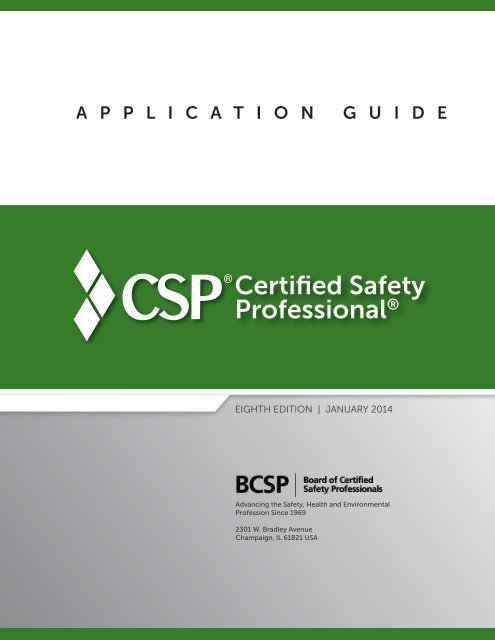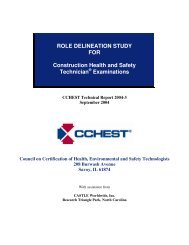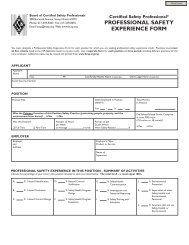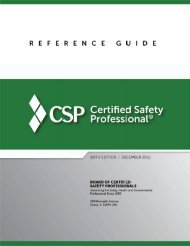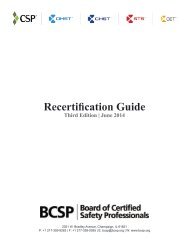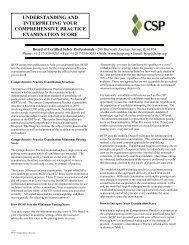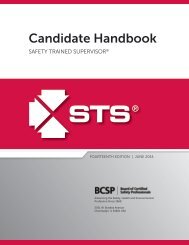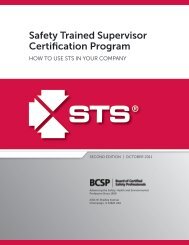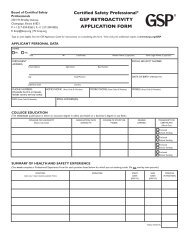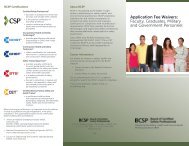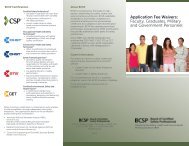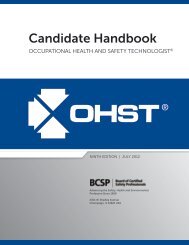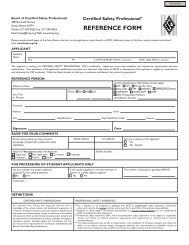CSP Application Guide - Board of Certified Safety Professionals
CSP Application Guide - Board of Certified Safety Professionals
CSP Application Guide - Board of Certified Safety Professionals
- No tags were found...
You also want an ePaper? Increase the reach of your titles
YUMPU automatically turns print PDFs into web optimized ePapers that Google loves.
A P P L I C A T I O N G U I D E<strong>Certified</strong> <strong>Safety</strong>Pr<strong>of</strong>essional ®EIGHTH EDITION | JANUARY 2014Advancing the <strong>Safety</strong>, Health and EnvironmentalPr<strong>of</strong>ession Since 19692301 W. Bradley AvenueChampaign, IL 61821 USA
© 2014 <strong>Board</strong> <strong>of</strong> <strong>Certified</strong> <strong>Safety</strong> Pr<strong>of</strong>essionals,Champaign, Illinois, USAAll rights reserved.A B<strong>CSP</strong> PublicationAll or any part <strong>of</strong> this document may be freely copied and distributed with the followingrestrictions: Excerpts, in any form or medium, must include a formal statementacknowledging that the <strong>Board</strong> <strong>of</strong> <strong>Certified</strong> <strong>Safety</strong> Pr<strong>of</strong>essionals is the owner <strong>of</strong> thecopyrighted material excerpted from this document. Copies and redistributions <strong>of</strong> thiswhole document, in any form or medium, must include the entire copyright notice and therestrictions shown on this page.<strong>Certified</strong> <strong>Safety</strong> Pr<strong>of</strong>essional <strong>Application</strong> <strong>Guide</strong>Eighth EditionJanuary 2014
Table <strong>of</strong> ContentsGeneral Information and Qualifications............................................................................................................... 1Examination Information.......................................................................................................................................... 6Program Fees and Policies........................................................................................................................................ 7<strong>Application</strong> Instructions............................................................................................................................................ 8
General Information and QualificationsDefinitions<strong>Safety</strong><strong>Safety</strong> is recognizing, evaluating and controlling hazards andmanaging the associated information and programs in order toprevent harm to people, property and the environment.<strong>Safety</strong> Pr<strong>of</strong>essionalA safety pr<strong>of</strong>essional is one who applies the expertise gained froma study <strong>of</strong> safety science, principles, practices and other subjectsand from pr<strong>of</strong>essional safety experience to create or developprocedures, processes, standards, specifications, plans andsystems to achieve optimal control or reduction <strong>of</strong> the hazardsand exposures which may harm people, property and/or theenvironment.The <strong>Certified</strong> <strong>Safety</strong> Pr<strong>of</strong>essionalThe <strong>Certified</strong> <strong>Safety</strong> Pr<strong>of</strong>essional ® or <strong>CSP</strong> ®1 is a certificationawarded by the <strong>Board</strong> <strong>of</strong> <strong>Certified</strong> <strong>Safety</strong> Pr<strong>of</strong>essionals (B<strong>CSP</strong>)to individuals who meet all <strong>of</strong> the requirements for certificationestablished by B<strong>CSP</strong>. More information about the <strong>CSP</strong>certification and B<strong>CSP</strong> can be found at www.bcsp.org.<strong>Certified</strong> <strong>Safety</strong> Pr<strong>of</strong>essionals are:• Respected by other safety pr<strong>of</strong>essionals.• Honored by the safety pr<strong>of</strong>ession.• Preferred or required by most employers <strong>of</strong> safetypr<strong>of</strong>essionals.• Required in many government and private contracts.• Paid on average about $30,000 more per year than safetypr<strong>of</strong>essionals without certification.• Paid on average $600,000 or more than safety pr<strong>of</strong>essionalswithout certification over the span <strong>of</strong> a career.The <strong>CSP</strong> certification:• Is cited in many federal, state and local laws, regulations andstandards.• Is recognized by U.S. and international safety and healthorganizations.• Is held by 75% or more <strong>of</strong> the leaders in the safetypr<strong>of</strong>ession.• Adds $300 million to pay for safety pr<strong>of</strong>essionals annually.<strong>Safety</strong> pr<strong>of</strong>essionals may use the <strong>Certified</strong> <strong>Safety</strong> Pr<strong>of</strong>essional titlewhen they meet all requirements established by B<strong>CSP</strong> and areauthorized by B<strong>CSP</strong> to use the <strong>CSP</strong> certification.The Associate <strong>Safety</strong> Pr<strong>of</strong>essional (ASP) is a temporarydesignation awarded by B<strong>CSP</strong>. It means that an individual hasmet the academic requirement for the <strong>CSP</strong> certification and haspassed the ASP examination—the first <strong>of</strong> two examinationsleading to the <strong>CSP</strong> credential. You only submit one applicationfor both the ASP designation and <strong>CSP</strong> certification.The <strong>CSP</strong> certification meets the highest national and internationalstandards for certifications and is accredited by the NationalCommission for Certifying Agencies (NCCA) 2 and AmericanNational Standards Institute (ANSI) 3The process <strong>of</strong> becoming a <strong>CSP</strong> includes the following:• Complete and submit application materials. B<strong>CSP</strong> will reviewyour application materials to determine if you meet theacademic and experience requirements and are eligible forthe ASP and/or the <strong>CSP</strong> examinations. If eligible, B<strong>CSP</strong>will inform you how long you are eligible and when youreligibility will expire.• Register for, pay for and pass the examination(s) leading tothe <strong>CSP</strong> certification. You may register with B<strong>CSP</strong> for anexamination at any time, as long as you are eligible. B<strong>CSP</strong>will notify our examination delivery service provider thatyou are an eligible candidate, and will inform you howlong you have to make an appointment and complete yourexamination.• Make an appointment to take your examination at a testingcenter near you and sit for your examination at the scheduledtime. Most testing centers around the world are open everybusiness day and many have evening and weekend hours.You will take your examination by computer and receivepass/fail result as soon as you log <strong>of</strong>f the computer system.If you fail an examination and are still eligible, you mayregister again as soon as you receive post-examinationinformation from B<strong>CSP</strong>.• Complete all requirements for the <strong>CSP</strong> certification. Aftercompleting all requirements for the <strong>CSP</strong> certification, B<strong>CSP</strong>will award you use <strong>of</strong> the <strong>CSP</strong> credential on an annual basisas long as you pay an annual renewal fee each year andmeet Recertification requirements every five years.1 <strong>Certified</strong> <strong>Safety</strong> Pr<strong>of</strong>essional ® and <strong>CSP</strong> ® are registered certification markswith the U.S. Patent and Trademark Office.2 National Commission for Certifying Agencies, 2025 M Street, NW, Suite 800,Washington, DC 20036, Phone: 202-367-1165, Web: www.credentialingexcellence.org.3 American National Standards Institute, 25 West 43rd Street, 4th Floor, NewYork, NY 10036, Phone: 212-642-4900, Web: www.ansi.org.1
QualificationsTo qualify for the <strong>CSP</strong> certification you must:• Apply to the <strong>Board</strong> <strong>of</strong> <strong>Certified</strong> <strong>Safety</strong> Pr<strong>of</strong>essionals.• Meet the academic requirements.• Meet the pr<strong>of</strong>essional safety experience requirement.• Pass the ASP examination (or be granted a waiver <strong>of</strong> theASP examination).• Pass the <strong>CSP</strong> examination.The Academic RequirementMinimum EducationA <strong>CSP</strong> candidate must meet one <strong>of</strong> the following minimumeducational qualifications:• A bachelor’s degree or higher in any field; or• An associate degree in safety, health, or the environmentThere is no waiver <strong>of</strong> the academic requirement and you mustprovide pro<strong>of</strong> that you were awarded the minimum qualifyingdegree.For U.S. degrees, B<strong>CSP</strong> requires that the educational institutionholds institutional accreditation from an accreditation body withinstitutional accrediting authority recognized by the Councilfor Higher Education Accreditation 4 (CHEA) and/or the U.S.Department <strong>of</strong> Education 5 (ED).The degree must have been awarded during the period <strong>of</strong>accreditation. Check with your school, CHEA (www.chea.org) orED (www.ope.ed.gov/accreditation) to determine whether yourschool was accredited when you earned your degree.There are two forms <strong>of</strong> accreditation: institutional andspecialized/pr<strong>of</strong>essional. Institutional accreditation establisheswhether a college or university meets minimum standards as adegree granting institution. Specialized/pr<strong>of</strong>essional accreditationevaluates specific degrees to determine whether the degreeprogram meets minimum standards for preparing individuals fora field <strong>of</strong> practice covered by the accreditation procedure.B<strong>CSP</strong> relies on institutional accreditation to determineacceptability <strong>of</strong> degrees and uses specialized/pr<strong>of</strong>essionalaccreditation to establish the credit allowed for a degree towardeligibility to sit for the <strong>CSP</strong> examinations.4 Council for Higher Education Accreditation, One Dupont Circle NW,Suite 510, Washington, DC 20036-1135, Phone: 202-955-6126, Web: www.chea.org.5 U.S. Department <strong>of</strong> Education, 400 Maryland Avenue, SW, Washington,DC 20202, Phone: 800-USA-LEARN, Web: www.ope.ed.gov/accreditation.Unaccredited DegreesUnaccredited degrees are a growing concern and at least fivestates now have laws making it illegal to use unaccrediteddegrees.B<strong>CSP</strong> policy on unaccredited degrees is as follows:Applicants and Certificants Cannot Use Unaccredited Degrees.B<strong>CSP</strong> has determined that it is unethical to use unaccrediteddegrees and such use is a violation <strong>of</strong> the B<strong>CSP</strong> Code <strong>of</strong> Ethics(see Interpretation #1 at www.bcsp.org/pdf/B<strong>CSP</strong>code<strong>of</strong>ethics.pdf). When B<strong>CSP</strong> becomes aware that an individual is using anunaccredited degree (i.e. it appears on a <strong>CSP</strong> <strong>Application</strong> Formor elsewhere), B<strong>CSP</strong> will ask the individual to sign a statementindicating whether they wish to continue using the unaccrediteddegree or to pursue or retain the <strong>CSP</strong> certification. Individualswishing to pursue the <strong>CSP</strong> certification or those holding it cannotuse an unaccredited degree. Failure to file the statement meansthat B<strong>CSP</strong> will terminate the application or certification.Associate Degree EvaluationB<strong>CSP</strong> will accept an associate degree from an accreditedinstitution for which the major is in the safety, health andenvironmental domain <strong>of</strong> practice covered by the <strong>CSP</strong>. B<strong>CSP</strong>has a broad view on the practice <strong>of</strong> safety and uses that view todetermine what associate degrees meet the minimum educationalrequirement. B<strong>CSP</strong> considers fields closely related to safety,health and the environment to be part <strong>of</strong> the safety domain.For example, associate degrees in safety, industrial hygiene,occupational safety and health, environment, health physics, fireprotection, or fire prevention are likely to qualify as a “safetyrelated” associate degree.To locate academic programs at accredited U.S. colleges anduniversities, visit www.bcsp.org/School_Directory for the B<strong>CSP</strong>Schools and Academic Programs Directory.International Degree EvaluationB<strong>CSP</strong> requires that all degrees from colleges and universitiesoutside the United States be evaluated for U.S. equivalency by anyNACES® members. To complete the evaluation process contactone <strong>of</strong> the agencies listed on the NACES website at www.naces.org. B<strong>CSP</strong> recommends that you have your academic degreeevaluated before applying for certification.Be sure to indicate within your NACES application that an <strong>of</strong>ficialcopy <strong>of</strong> your evaluation be sent directly to B<strong>CSP</strong>. Once yourdegree has been evaluated, the appropriate NACES member willreturn your original documents along with your evaluation reportand send a copy <strong>of</strong> the report directly to B<strong>CSP</strong>.2
B<strong>CSP</strong> Eligibility Point SystemB<strong>CSP</strong> uses a point system to determine eligibility forexaminations. You must have at least 48 points to sit for the ASPexamination and after passing or receiving a waiver for the ASPexamination, at least 96 points to sit for the <strong>CSP</strong> examination.You can earn points through education, experience and othercertifications.Academic Points + Experience Points + Certification Points =Total Eligibility PointsTable 1 lists eligibility points awarded for various degrees. Youmay use only one undergraduate and one graduate degree forcredit. If you hold more than one undergraduate or graduatedegree, only the degree yielding the highest point value willbe accepted. Continuing education courses, seminars, andcertificate programs are not a substitute for, and do not receivecredit toward, the academic requirement.A bachelor’s degree in safety from a program accredited by ABET 6earns the maximum 48 points. Refer to the ABET website (www.abet.org) for accreditation standards and a listing <strong>of</strong> accrediteddegree programs.Many people enter the safety pr<strong>of</strong>ession from other educationalbackgrounds and their degrees alone do not achieve the 48eligibility points needed to sit for the ASP examination. They mayuse advanced degrees and/or pr<strong>of</strong>essional safety experience toearn additional points.In addition to degrees and experience, candidates earn pointsfor holding the Occupational Health and <strong>Safety</strong> Technologist ®(OHST ® ) or Construction Health and <strong>Safety</strong> Technician ®(CHST ® ) certifications. You are awarded 12 points if you hold theOHST or CHST at the time <strong>of</strong> application or after. If more thanone certification is held, the maximum number <strong>of</strong> points awardedis still 12.The Experience Requirement<strong>CSP</strong> candidates must have pr<strong>of</strong>essional safety experience. Theexact number <strong>of</strong> years depends on their degree(s) and if theyhold OHST or CHST certification. B<strong>CSP</strong> has a broad definition <strong>of</strong>safety. Pr<strong>of</strong>essional-level work experience in safety, health, environmentalprotection, fire protection, ergonomics, radiation protectionand industrial hygiene is considered pr<strong>of</strong>essional safetyexperience.All pr<strong>of</strong>essional safety experience must meet all <strong>of</strong> the fivefollowing criteria to be acceptable to B<strong>CSP</strong>:2. The position’s primary responsibility must be theprevention <strong>of</strong> harm to people, property, or theenvironment, rather than responsibility for responding toharmful events.3. Pr<strong>of</strong>essional safety functions must be at least 50% <strong>of</strong> theposition duties. B<strong>CSP</strong> defines full-time as at least 35hours per week. Part-time safety experience is allowedinstead <strong>of</strong> full-time safety experience if the applicant hasthe equivalent <strong>of</strong> at least 900 hours <strong>of</strong> pr<strong>of</strong>essional safetywork during any year (75 hours per month or 18 hoursper week) for which experience credit is sought.4. The position must be at the pr<strong>of</strong>essional level. This isdetermined by evaluating the degree <strong>of</strong> responsiblecharge and reliance <strong>of</strong> employers or clients on theperson’s ability to defend analytical approachesused in pr<strong>of</strong>essional practice. Responsible charge alsoencompasses their recommending how to control hazardsthrough engineering and/or administrative approaches.5. The position must have breadth <strong>of</strong> pr<strong>of</strong>essional safetyduties. This is determined by evaluating the variety <strong>of</strong>hazards about which the candidate must advise and therange <strong>of</strong> skills involved in recognizing, evaluating, andcontrolling hazards. Examples <strong>of</strong> skills are analyzing,synthesizing, designing, investigating, planning,administrating, and communicating.Each month <strong>of</strong> acceptable pr<strong>of</strong>essional safety experience earnsone point. Each position is evaluated separately.A percentage <strong>of</strong> <strong>CSP</strong> <strong>Application</strong>s will be randomly selectedto have their Pr<strong>of</strong>essional <strong>Safety</strong> Experience Form(s) audited.If your application is selected, you will be notified to providedocumentation validating your experience.Experience UpdatesAt the time <strong>of</strong> application, many candidates have enough pointsto sit for the ASP examination (48), but do not have the pointsrequired for the <strong>CSP</strong> examination (96). In this instance, B<strong>CSP</strong>estimates when you will achieve 96 points assuming you remainemployed in a position that meets pr<strong>of</strong>essional safety practicerequirements. Near that estimated date, you must submit aPr<strong>of</strong>essional <strong>Safety</strong> Experience Update Form to B<strong>CSP</strong>. This form islocated at www.bcsp.org/<strong>CSP</strong>.If 96 points are not met after the candidate’s work experienceis updated, B<strong>CSP</strong> estimates a new eligibility date. Candidatesmay be dropped from the <strong>CSP</strong> process if they fail to provideupdated information when requested, or have not meteligibility requirements at the end <strong>of</strong> the third year from theoriginal projected eligibility date.1. Pr<strong>of</strong>essional safety must be the primary function <strong>of</strong> theposition. Collateral duties in safety are not considered theprimary function.3
Table 1 Academic CreditDegree/Program Major<strong>Safety</strong>, Health, Environment,Ergonomics<strong>Safety</strong>/Occupational <strong>Safety</strong> Fire Protection Engineering Environmental ScienceProgram Associate 2 Bachelor’s 2 Master’s 3 PhD. 3Accred 1YesNo2418483612924 424 4Industrial Hygiene/OccupationalHealthFire Protection EngineeringTechnologyEnvironmental HealthHealth Physics/Radiation <strong>Safety</strong> Occupational Health/Hygiene Ergonomics<strong>Safety</strong> Engineering Fire Science Environmental Management<strong>Safety</strong> Engineering Technology Loss Control Management Environmental EngineeringEngineering 15 30 8 15Chemical Engineering Electrical/Electronic Engineering Mechanical EngineeringCivil Engineering Engineering Mechanics Structural EngineeringComputer Engineering Industrial Engineering Other Engineering SpecialtyEngineering Technology 15 30 8 15Any specialty (other than safety orenvironment)Natural, Physical and HealthSciencesAgriculture/AgronomyBiology/Microbiology/Zoology/Physiology/Botany/Entomology/Animal ScienceGeneral ScienceArchitecture Computer Science Geology/Earth SciencesAstronomyAviationMathematicsPhysicsChemistry/Biochemistry Forestry Waste ManagementMedicine, Nursing, HealthSciencesMedicine Allied Health Sciences ToxicologyNursingBusiness, Management, andLawPublic HealthBusiness Administration Finance Specialty Management, such as:Business Management Marketing Aviation, Security, etc.Accounting Management Law15 30 8 1515 30 8 1515 30 8 15Industrial Technology 15 30 8 15Any specialty (other than safety orenvironmentLiberal Arts, Education, SocialScienceAnthropology Art Criminal JusticeApplied/Industrial ArtsCommunicationIndustrial Education9 18 5 9EducationGeographyHumanitiesPolitical ScienceSocial WorkIndustrial ArtsHistoryJournalismPsychologySociologyForeign LanguageGeneral StudiesLiberal ArtsEducational PsychologyUrban PlanningOther Liberal ArtsNote 1. B<strong>CSP</strong> relies on ABET and certain other acceptable program accreditations for safety and related degrees to set policy on eligibility points and participation in the Graduate <strong>Safety</strong>Practitioner (GSP) program as a Qualified Academic Program (refer to the GSP <strong>Application</strong> <strong>Guide</strong>).Note 2. The minimum academic requirement is an associate’s degree in safety or closely-related field. If more than one undergraduate degree is held, B<strong>CSP</strong> awards credit for the one degree<strong>of</strong>fering the highest points. The only circumstance that the non-safety associate’s degree is awarded points is if the minimum academic requirement is met with an accredited master’s or PhDdegree and no credit is awarded for the bachelor’s degree.Note 3. For more than one advanced (post-bachelor) degree, B<strong>CSP</strong> awards credit for the one degree <strong>of</strong>fering the highest credit.Note 4. Doctoral degrees are not accredited due to their customized structure. Any safety or safety-related doctorate degree earns 24 points.4
Candidate Eligibility Time LimitsCandidates for the <strong>CSP</strong> credential have specific time limits totake and/or successfully pass examinations. Candidates for theASP examination must sit for the examination once every threeyears once they are eligible, until they pass. Candidates for the<strong>CSP</strong> examination must pass the examination within three years <strong>of</strong>becoming eligible.B<strong>CSP</strong> allows candidates to extend their eligibility time limit onceduring their term for each examination. This extension is valid forone year.Those who do not meet these time limits or purchase theeligibility extension must reapply as a new candidate. A detailedoutline <strong>of</strong> eligibility and other time limits and eligibility extensionoptions is provided once an application has been approved.Note: Eligibility time limits are independent <strong>of</strong> examinationauthorization time limits.Graduate <strong>Safety</strong> Practitioner (GSP) ProgramThe GSP program is an additional path to the <strong>CSP</strong> certificationavailable to graduates <strong>of</strong> bachelor’s or master’s safety degreesthat meet B<strong>CSP</strong> Qualified Academic Program (QAP) standards.More information about the GSP program, and a list <strong>of</strong> degreeprograms that are eligible to participate, is located at www.bcsp.org/GSP. Those accepted into the GSP program receive a waiver<strong>of</strong> the <strong>CSP</strong> application fee and the ASP examination.5
Examination InformationThe companion publications to the <strong>CSP</strong> <strong>Application</strong> <strong>Guide</strong>, theASP and <strong>CSP</strong> Examination <strong>Guide</strong>s, provide important informationabout B<strong>CSP</strong> examination content, preparing for examinations,study materials <strong>of</strong>fered by other organizations, and examinationprocedures. It is essential to obtain these guides when preparingfor examinations. They are free publications and located at www.bcsp.org/<strong>CSP</strong>.To help you determine your strengths and weaknesses and reviewthe format <strong>of</strong> the ASP and <strong>CSP</strong> examinations, B<strong>CSP</strong> <strong>of</strong>fers selfassessmentexaminations. These self-assessment examinationsare comprised <strong>of</strong> test questions similar to the actual examinations(50% in length). A self-assessment examination order form islocated at www.bcsp.org/<strong>CSP</strong>.Examination Security and IntegrityOne key to a successful and respected certification program isexamination security. B<strong>CSP</strong> relies on the ethical behavior <strong>of</strong>candidates and certificants to maintain the security <strong>of</strong> B<strong>CSP</strong>examinations. When those who hold the <strong>CSP</strong> credential, or thosewho are pursuing the <strong>CSP</strong> credential, reveal information about thecontent <strong>of</strong> B<strong>CSP</strong> examinations (other than that which is publishedby B<strong>CSP</strong>), they violate the agreement all candidates accept whenthey apply for certification and take an examination. They alsoviolate the B<strong>CSP</strong> Bylaws and the B<strong>CSP</strong> Code <strong>of</strong> Ethics. B<strong>CSP</strong> hastaken action and will continue to take action against individualswho violate this trust. Penalties may include permanently barringindividuals from pursuing the <strong>CSP</strong> credential and revoking thecertificates <strong>of</strong> those holding the ASP or GSP designation or <strong>CSP</strong>certification, in addition to other legal remedies.Waivers <strong>of</strong> the ASP ExaminationAll candidates must pass the <strong>CSP</strong> examination. The firstexamination, ASP, covers basic knowledge appropriate topr<strong>of</strong>essional safety practice. Candidates with 48 points can sitfor this examination. Upon passing it, candidates receive thetemporary ASP designation to denote their progress toward the<strong>CSP</strong> certification.Those candidates qualifying for the GSP designation and somecandidates who have been examined through other acceptablecredentialing programs, and currently hold such credentials,may be granted a waiver <strong>of</strong> the ASP examination. B<strong>CSP</strong>currently accepts only the following certifications, licenses ormemberships for waiver <strong>of</strong> this examination:• <strong>Certified</strong> Industrial Hygienist (CIH) from the American<strong>Board</strong> <strong>of</strong> Industrial Hygiene.• Chartered Member <strong>of</strong> IOSH (CMIOSH) from theInstitution <strong>of</strong> Occupational <strong>Safety</strong> and Health.• Canadian Registered <strong>Safety</strong> Pr<strong>of</strong>essional (CRSP) fromthe <strong>Board</strong> <strong>of</strong> Canadian Registered <strong>Safety</strong> Pr<strong>of</strong>essionals.• Pr<strong>of</strong>essional Member holding a Workplace <strong>Safety</strong> &Health Officer designation from the Singapore Ministry<strong>of</strong> Manpower, Singapore Institute <strong>of</strong> <strong>Safety</strong> Officers (SISO).Those who receive a waiver <strong>of</strong> the ASP examination do notreceive and cannot use the ASP title. Candidates who pass theASP examination (or are granted a waiver <strong>of</strong> it) and earn 96 pointsare eligible for the <strong>CSP</strong> examination.B<strong>CSP</strong> will also pursue legal action against organizations orindividuals not seeking certification who reveal informationabout the content <strong>of</strong> B<strong>CSP</strong> examinations (other than that which ispublished by B<strong>CSP</strong>).B<strong>CSP</strong> examinations are closed book, except for your authorizedcalculator(s) and any materials provided by examinationmanagement staff. Once your examination clock starts, youmay not access any materials beyond those given to you by theexamination management staff until you formally submit yourexamination for scoring. During self-scheduled breaks, you arenot permitted to access any written or electronic materials or havecontact with anyone other than staff. B<strong>CSP</strong> will invalidate yourexamination and pursue disciplinary charges in accordance withB<strong>CSP</strong> Bylaws and Discipline Policy if you access prohibitedmaterials, have contact with anyone except examinationmanagement staff, leave the building while your examinationclock is running, or engage in unethical, disruptive, orunpr<strong>of</strong>essional conduct at a testing center.6
Program Fees and PoliciesThe most up-to-date and accurate application, examination andrenewal fees can be found at www.bcsp.org/AtaGlance.Fees are nonrefundable and nontransferable. Checks and moneyorders must be payable to B<strong>CSP</strong>. All fees must be payable in U.S.dollars drawn on a U.S. bank. Fees are subject to change at anytime without notice.Non-sufficient fund (NSF) checks will stop action on theapplication/examination process for any candidate covered by thecheck and the check originator will be billed for any related NSFfees.Other fees may apply upon achieving the ASP designation or<strong>CSP</strong> certification. For example, individuals who pay their annualrenewal fee late may incur a late charge or a reinstatement fee ifB<strong>CSP</strong> has acted to terminate certification.Non-DiscriminationB<strong>CSP</strong> evaluates all candidates seeking the <strong>CSP</strong> certificationwithout regard to religion, ethnicity, gender, age, national origin,disability, or sexual orientation.AppealsYou may appeal decisions related to earning and maintainingB<strong>CSP</strong> credentials.Requests for appeal must be submitted to the Chief ExecutiveOfficer in writing and in accordance to the current appeals policylocated online at www.bcsp.org/About_B<strong>CSP</strong>.Unemployed certificants may request a one-year annual renewalfee waiver in writing only once during their history with B<strong>CSP</strong>.The U.S. Department <strong>of</strong> Veterans Affairs (VA) (www.va.gov)reimburses certification test fees for active duty, reservecomponent, and military retirees personnel eligible under variousentitlement programs. Contact your local VA Regional Office(888-442-4551) for more information on the reimbursement <strong>of</strong>B<strong>CSP</strong> examination fees.7
<strong>Application</strong> InstructionsGeneralIndividuals who wish to pursue the <strong>CSP</strong> must submit a completeapplication. Candidates for the <strong>CSP</strong> apply only once, providedthey follow all policies and stay within their time limits.B<strong>CSP</strong> can act only on the information you include in theapplication. Complete and well-written information will helpevaluators to determine eligibility. All applications must besigned. <strong>Application</strong> and Experience Forms may be emailed toCustomer Service at customerservice@bcsp.org.All necessary forms can be viewed, edited and printed fromwww.bcsp.org/<strong>CSP</strong>. All forms must be typed or legibly printed.You should prepare a draft copy first and then prepare andmail a final copy. Do not send resumes, pr<strong>of</strong>essional papers,continuing education course certificates, or any other items thatare not specifically requested in these instructions.Applicant Personal Data• Check Mr. or Ms. Use your legal, given name as itappears on your government-issued identification. Do notuse nicknames. Provide any previous names that mayappear on transcripts or other papers. You must notify B<strong>CSP</strong>about any subsequent name changes, and submit a copy <strong>of</strong>the legal document (marriage certificate, divorce decree,court order, etc.) creating the change.• Provide your home address. You must notify B<strong>CSP</strong>about any address changes.• Provide your date <strong>of</strong> birth (MM/DD/YY).• Select one North American Industry ClassificationSystem (NAICS) code from the table <strong>of</strong> NAICS codes(Table 2 on page 9) which best fits your currentposition. If your employer has multiple functions, youmay add a second NAICS code on the application.NAICS has replaced the U.S. Standard IndustrialClassification (SIC) system.• Provide your home, work, cell and fax phonenumbers. For numbers outside the U.S. and Canada, pleaseinclude the country and city codes.• Provide your email address(es).College EducationFor each degree:• List the college name(s), city, and state.• List the graduation date.• List your major or program <strong>of</strong> study title as it appears onyour transcript.• List the degree(s) earned. Specify associate, bachelor’s,master’s or doctoral degree.• Check one appropriate box to indicate whether yourtranscript(s) are enclosed or the school(s) are sending them.Do not send photocopies.For each degree for which you are seeking credit, an <strong>of</strong>ficialtranscript in a university sealed envelope with a confirmedgraduation date from the issuing university is required. Theschool should send it directly to B<strong>CSP</strong>. You can only earncredit for one undergraduate degree and one graduate degree.You should send the transcript for the degree(s) which earn thehighest number <strong>of</strong> points. If you hold more than one bachelor’sor master’s degree, you must provide the transcript for the degreethat provides the most eligibility points. See Table 1.Summary <strong>of</strong> Pr<strong>of</strong>essional <strong>Safety</strong> ExperienceList each full-time and qualifying part-time position for whichyou are seeking credit in reverse chronological order (i.e. mostrecent first). Each position must cover a separate and distincttime period and should not overlap.• List each pr<strong>of</strong>essional title <strong>of</strong> the position.• List the employer for each position.• List the month and year for each start and end date.• List the number <strong>of</strong> months in each position.You must enclose a Pr<strong>of</strong>essional <strong>Safety</strong> Experience Form for eachposition for which you are seeking credit.Certifications, Licenses, and MembershipsOf the ones listed, mark all certifications, licenses, andmemberships that you currently hold and are in good standing.B<strong>CSP</strong> will also verify the status with the issuing organizationbefore granting a waiver <strong>of</strong> the ASP examination or awardingeligibility credit. Any misrepresentations will be reported.If you hold the OHST and/or CHST, specify this by checking theappropriate box. If you hold the OHST or CHST at the time <strong>of</strong>application or after, you will be awarded 12 eligibility points. Ifboth certifications are held, the maximum number <strong>of</strong> eligibilitypoints awarded is still 12.Pr<strong>of</strong>essional Society MembershipsOf the ones listed, check all pr<strong>of</strong>essional health and safetysocieties <strong>of</strong> which you are a current member.8
Table 2. NAICS Codes9
Primary <strong>Safety</strong> SpecialtyCheck only one specialty that best describes your overallqualifications.ValidationB<strong>CSP</strong> requires applicants to disclose criminal convictions,disciplinary actions, and denial or revoked certifications, licensesand pr<strong>of</strong>essional registrations. B<strong>CSP</strong> uses its policy relating tocriminal convictions to determine whether the application canproceed or whether it will be terminated. In some cases, a B<strong>CSP</strong>attorney may contact the applicant to clarify information aboutthe conviction. A copy <strong>of</strong> the B<strong>CSP</strong> criminal conviction policyappears at www.bcsp.org/About_B<strong>CSP</strong>.B<strong>CSP</strong> also requires applicants to disclose any disciplinary actionsor denial <strong>of</strong> certifications, licenses or pr<strong>of</strong>essional registrationstaken against the applicant by the issuing certification boardor agency. B<strong>CSP</strong> determines whether the action should beconsidered in the certification application process.Applicants are required to provide disclosure <strong>of</strong>:• All felony convictions• All misdemeanor convictions within the past five (5) years(Minor traffic violations and petty <strong>of</strong>fenses DO NOT have tobe reported)• Any record <strong>of</strong> unethical behavior • Information related to having a pr<strong>of</strong>essional license orcertification denied, suspended or revoked for reasons otherthan not meeting qualifications, failure <strong>of</strong> examination, orfailure to pay renewal fees<strong>Application</strong> Payment Information• Indicate how you are paying your application fee.The application fee is nonrefundable and nontransferable.• If you pay by check or money order, fees must be inU.S. dollars and made payable to the <strong>Board</strong> <strong>of</strong> <strong>Certified</strong><strong>Safety</strong> Pr<strong>of</strong>essionals or B<strong>CSP</strong>. All checks must bedrawn on a U.S. bank. Attach the check or money orderto the front <strong>of</strong> the <strong>CSP</strong> <strong>Application</strong> Form.• If you pay by credit card, please record the type<strong>of</strong> card, credit card number, expiration date, the CVV/CVV2, billing address and name on card, sign your name,and enter the date. The CVV/CVV2 code is a 3- or 4-digitverification code on your credit card.This number is printed on the back <strong>of</strong> MasterCard, VISA, andDiscover/Novus credit cards in the signature area after thecredit card number. You can find the 4-digit number on thefront <strong>of</strong> American Express cards above and to the right or left<strong>of</strong> the credit card number.Pr<strong>of</strong>essional Advancement Mentor ProgramMany <strong>CSP</strong>s encourage, assist, or require fellow safetypr<strong>of</strong>essionals to pursue certification to advance their careers.B<strong>CSP</strong> recognizes these contributions through the B<strong>CSP</strong>Pr<strong>of</strong>essional Advancement Mentor Program. Applicantsand mentors can participate by completing a Pr<strong>of</strong>essionalAdvancement Mentor Program Form and submitting it with thecandidate’s application. Forms and more information are locatedat www.bcsp.org.Completing Pr<strong>of</strong>essional <strong>Safety</strong> Experience FormsBeginning with your current position, complete a separatePr<strong>of</strong>essional <strong>Safety</strong> Experience Form for each position for whichyou are seeking credit. If you held more than one position withan employer, you must complete a separate Pr<strong>of</strong>essional <strong>Safety</strong>Experience Form for each position.All sections must be completed. Please refer to page 3 for anexplanation <strong>of</strong> acceptable safety experience before completingyour forms. In the SUMMARY OF ACTIVITIES section writein each space the percent <strong>of</strong> time that you devoted to each <strong>of</strong>twelve major areas <strong>of</strong> pr<strong>of</strong>essional safety practice. All functions(A-L) must total 100%. Refer to Table 3 for a description <strong>of</strong> eachcategory.One <strong>of</strong> the most important items included with your applicationis the Pr<strong>of</strong>essional <strong>Safety</strong> Experience Form. Provide a completedescription <strong>of</strong> your three primary position functions that dealwith areas A through K. Do NOT provide a description for areaL (Functions that are not <strong>Safety</strong>, Health, or Environmental).Evaluators can only consider the information provided. Ifinformation does not clearly define job functions in detail, orgive specific examples <strong>of</strong> work activity, evaluators cannot awardcredit for the work experience.B<strong>CSP</strong> may request additional information to decide on credit for aposition, and such requests may delay the evaluation process. Donot submit formal job descriptions or resumes.Submitting Your <strong>Application</strong>Make a copy <strong>of</strong> all application materials for your records. Keeptogether multiple pages for each form and paper clip all materialstogether with the check or money order (if used) on top. Do notstaple the materials, bind them together or place them in a folder.Send materials to:<strong>Application</strong>s<strong>Board</strong> <strong>of</strong> <strong>Certified</strong> <strong>Safety</strong> Pr<strong>of</strong>essionals2301 W. Bradley AvenueChampaign, IL 6182110
Table 3. Pr<strong>of</strong>essional <strong>Safety</strong> Job FunctionsHazard Identification: All activity related to the identification/verification<strong>of</strong> conditions, methods, or processes having the potential to cause damage orinjury to people or property. Examples <strong>of</strong> tasks: visual inspections, review <strong>of</strong>documentation, interviews or inquiries, literature searches, application <strong>of</strong> hazardanalysis methods or system safety analyses.Hazard Evaluation: The review <strong>of</strong> recognized hazards associated withconditions, methods and processes or the comparing <strong>of</strong> existing hazard levelsto standards. Examples: safety testing <strong>of</strong> equipment or processes, industrialhygiene sampling and analysis, and making computations to establish the level<strong>of</strong> hazard or risk.Hazard Control Design: Developing or proposing new methods, devices,equipment or processes that will reduce the level <strong>of</strong> hazard exposure by anacceptable amount. Examples: literature searches and consultations with experts,managers or others to identify potential hazard controls and their integrationinto existing designs or actually designing controls.Hazard Control Verification: All activity carried out to ensure that existinghazard control measures are performing as designed. Examples: conductingphysical audits and tests <strong>of</strong> methods, devices, equipment and processes anddetermining if hazard controls are in place and functioning properly.<strong>Safety</strong>/Health Program Design: The planning, preparation and proposal <strong>of</strong>written policies and programmatic descriptions explaining systematic methodsand procedures and assigning responsibilities for reducing the risk <strong>of</strong> personal injury,death or property damage. Examples: consultations and discussions with managers and<strong>of</strong>ficials about new or modified safety and health programs directly related tohazard control efforts.<strong>Safety</strong>/Health Program Evaluation: The review <strong>of</strong> existing safety and healthprograms in order to determine if program objectives are achieved. Examples:auditing <strong>of</strong> program activities, statistical analysis <strong>of</strong> program performance, andrecommending modifications to existing programs.<strong>Safety</strong>/Health Communication: The development <strong>of</strong> audio, audiovisual, printedmaterials and other communication media based on identified problems, solutionsand implementations which are directed at employees, supervision, management andexternal audiences to assist in abating accidents, injuries, or illnesses or toinform <strong>of</strong> safety and health problems and progress (not already included underthe above categories).Investigation and Statistical Reporting: The inquiry into complaints, claimedor real exposures, review <strong>of</strong> accidents, incidents, injuries and illnesses that haveoccurred along with the review <strong>of</strong> resource literature and related standards. Thedetermination <strong>of</strong> possible causal factors and remedial measures. This activity mayinclude the compilation <strong>of</strong> data and preparation <strong>of</strong> reports.<strong>Safety</strong> Training/Education: The selection and packaging <strong>of</strong> hazard-relatedinformation to assist various audiences in accepting, understanding and applyingknowledge to their respective activities, duties and responsibilities. The audiences mayinclude employees, supervisors, managers, pr<strong>of</strong>essional and technical people,and the public.Supervision <strong>of</strong> Other <strong>Safety</strong> Personnel: The direction <strong>of</strong> subordinate safetyand health personnel in order to support hazard control programs. This mayinclude routine supervision, technical guidance and evaluation <strong>of</strong> pr<strong>of</strong>essionalperformance.Environmental Protection: All activity carried out in order to characterizeand control potentially harmful agents, wastes and other effluents in order tominimize their damage to the environment and ecological systems.Neither <strong>Safety</strong>/Health Nor Environmental Functions: All activities whichdo not fall within any <strong>of</strong> the above eleven categories.11
#0646Advancing the <strong>Safety</strong>, Health and EnvironmentalPr<strong>of</strong>essional Since 19692301 W. Bradley Avenue, Champaign, IL 61821 USAP: +1 217-359-9263 | F: +1 217-359-0055www.bcsp.org1/14


